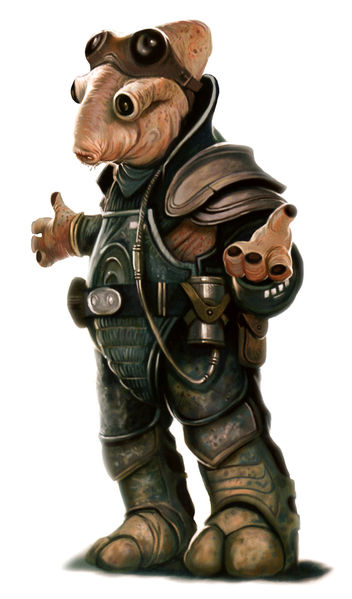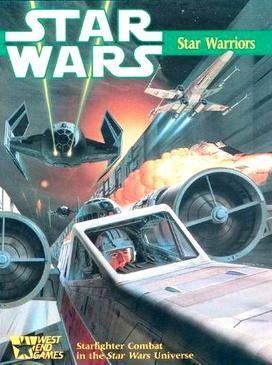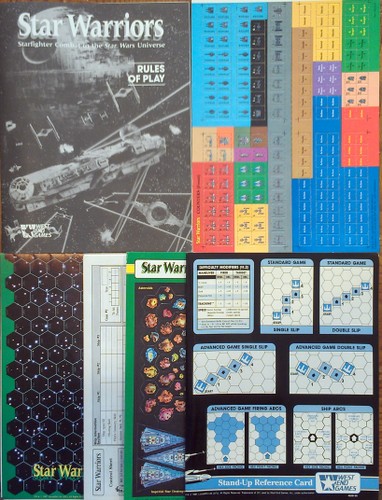One topic that often comes up from newcomers to 1E is the special version of initiative that is used in the game. People are used to rolling initiative in other rpgs to decide the order of actions in a combat round. Players are often confused when it comes to "initiative" in 1E because the game doesn't use a traditional initiative throw (though a traditional throw is used in 2E).
Initiative in 1E is extremely simple. After I got the hang of it, it became one of the chief things that I love about first edition D6 Star Wars.
Let me show you...
1E INITIATIVE
In 1E, narrative is king. The GM describes the opening circumstances in a combat round. "Two stormtroopers approach, each casually holding their blaster rifles. 'You there!' You hear from their mechanical voice boxes, 'Let's see some ID.'
Then the players react to that, telling the GM what they want their characters to do (this is the Declaration Segment). Jon says, out of character, "We don't have any valid ID. I'm going to draw on 'em. I'll pull my blaster and fire at the one on the left."
Fred agrees. "Yeah, my character will fire his blaster rifle at the one on the right."
The Ref mentally notes that Jon's character is drawing while firing, while Fred's character already has his weapon in his hands.
Initiative is sometimes organic. No type of roll is needed at all. If it is clear, though the situation and the intended actions of the PCs and NPCs, then no roll will be consulted at all. The Ref just directs the action as seems logical.
When one character can effect another character, as when one character is shooting a blaster at another, then some type of dicing is needed to see which character fired first.
In our situation above, the Ref will handle the combat in two stages. Jon's character is firing at the left stormtrooper. That will be handled separately from Fred's character firing at the right stormtrooper. If the left stormtrooper were firing at Fred's character, then that would be a situation where all four characters would be regarded together. But, as it stands, the Ref will resolve the Jon-->Left Trooper situation, then he will resolved the situation between Fred and the Right Trooper.
JON AND THE LEFT TROOPER
Jon is pulling his blaster from his hip holster and firing at the left trooper. Mentally (the Ref does not inform the player), the Ref decides that the trooper will dodge and fire back at Jon's character.
Behind the screen, the Ref rolls the trooper's 4D Dodge. He gets 6. Range is Short, so Jon's target number is 16.
The Ref says to Jon, "As you turn, the trooper quickly raises his blaster to fire back." This does two things. It alerts Jon to the stormtrooper's action this round--the trooper is firing at Jon just as Jon is firing at the trooper (it's information that Jon's character could pick up in a split second). Second, it gives Jon an opportunity to Dodge the trooper's shot. (Jon doesn't declare a Dodge).
Behind the screen, the Ref rolls the trooper's attack. 4D blaster skill, -1D due to armor, -1D due to the Dodge. 2D are rolled, getting a total of 3.
Jon, the player, rolls the attack for his character. 5D+1 blaster skill, -1D for the draw. 4D+1 is rolled, getting a total of 17.
The rolls for the blaster shots serve two purposes: As initiative, to decide who shoots first. Then as attacks, to see if a shot is successful.
In this case, Jon's roll is higher. Jon's character spins, pulls his weapon, and fires, hitting the trooper, before the trooper can lift his weapon and fire at Jon.
Jon's shot is successful because his attack of 17 is higher than the trooper's 16 Dodge.
The trooper never gets off his shot (or, for effect, the GM could describe a shot that went wild, blowing a divot in the ceiling.
Jon's blaster bolt slams into the trooper, knocking him down, smoking his armor. Damage from Jon's heavy blaster pistol is 5D. Rolled, the damage is 19.
The trooper's defense is 2D STR +1D armor. 3D are rolled, getting 14. This means the trooper is now Wounded.
FRANK AND THE RIGHT TROOPER
Frank has declared that he is going to raise his blaster rifle and fire at the right trooper.
The Ref has decided that the trooper is going to tongue his helmet comm to contact the patrol outpost and alert them to send back up for these Rebels.
So, we've got an initiative situation here. Can Frank shoot the trooper before the trooper can contact the outpost?
In order to find out, we compare Frank's blaster attack total with the trooper's Mechanical throw to operate the comm.
Frank's blaster attack is 3D, getting a total of 8.
The trooper's throw to operate the comm is 2D, getting a total of 6.
So, what happens? Frank's blaster attack wins initiative. The shot happens first. Range is Short, though, with a difficulty of 10. So, the shot misses the trooper.
The allows the trooper's action to go through. The comm roll is a 6, and the GM has set a difficulty of Very Easy to operate the comm. Since 6 beats the 5+ required to operate the comm, the trooper's message goes through.
THIS COMBAT ROUND
1. 2 Troopers Approach, asking for ID.
2. Jon swings around, pulls his blaster, and blasts the one on the right. He goes down with a smoking hole in his armor, wounded.
3. Frank raises his blaster rifle but misses the other trooper.
4. The standing trooper calls into the outpost, requesting back up troopers to this location.
INITIATIVE
What I like about this is a few things. First, there is no extra initiative throw. That makes the game move faster. Often, it is obvious the way the action should flow, and the GM just describes the action in a logical order.
Second, when initiative is needed to see what event happens first, the character uses the skill appropriate to what he is doing. If he's shooting, he uses his blaster skill. If he's moving, he uses his Dexterity. If he is using his helmet comm, then it is Mechanical. Characters will be quick where they are skilled and not as quick in the areas where they are not as experienced.
New player confusion often centers around the dual nature of a roll used for initiative. When Blaster skills is used, for example, the roll total is first considered as initiative and then the same roll is considered separately and secondary as a blaster attack. It is sometimes confusing to those new to this system when a character rolls a blaster attack, loses initiative, is shot, and then his blaster attack is regarded as if it never happened. This happened to the Left Stormtrooper in the above example. Jon won initative with his higher roll, and the shot was successful. Therefore, the trooper's blaster skill roll was only used for initiative and not as a blaster shot. Jon shot and wounded the trooper before he could fire.


